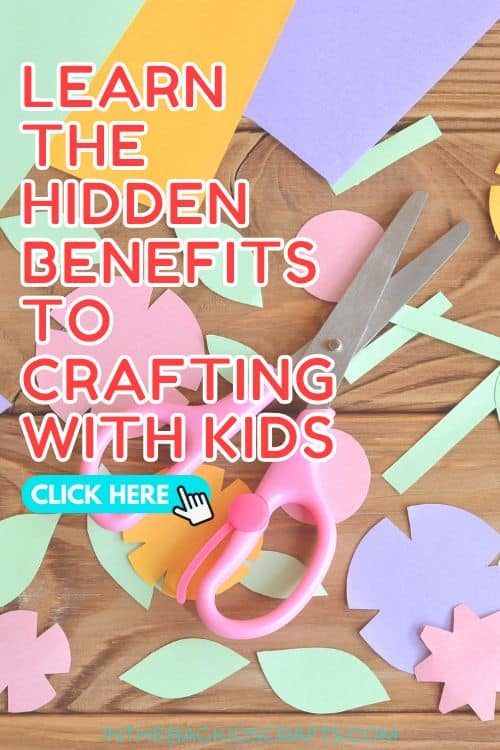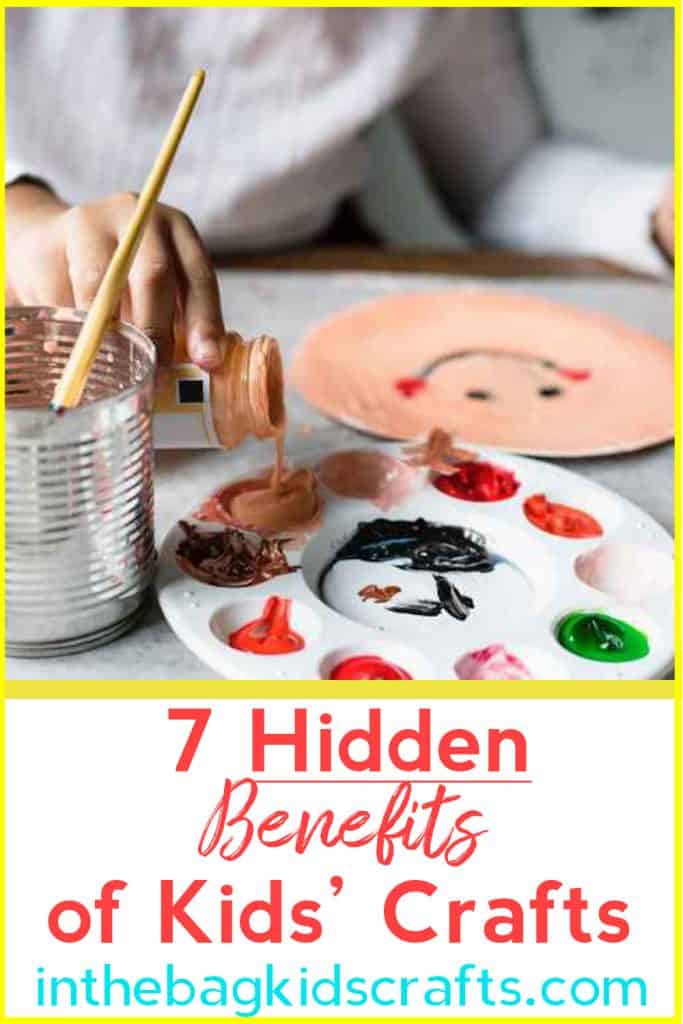7 Hidden Benefits of Crafting with Your Children
I know that I am probably biased (since I deal with crafts professionally), but it is soooo important for children to be doing crafts! Actually, it is not just my opinion. There is so much evidence to back this up. Plus, I have seen it firsthand! Aside from working on fine motor skills, there are so many hidden benefits of crafting with your kiddos that you may never have thought about before. Let’s talk about a few…

1. Exposure to new things
One of the things that I hear so often when working with preschoolers is, “Johnny doesn’t know how to color (or use scissors, draw, hold a crayon…whatever the skill may be) because he just doesn’t like to. So, we don’t make him.” Since the kiddo rejected an activity, such as coloring, the first time it was tried, the parent has never attempted to reintroduce it. Because, let’s face it, trying new things can be difficult! But not trying is even worse…because then we have little ones who are ready to head off to kindergarten who have not even held a crayon or a pair of scissors. They are at a deficit from the beginning and spend all year just trying to catch up with their peers.
If this sounds familiar, please, I am begging you, try again! Maybe take a different approach. HERE are a couple of ideas for ways to make crafts more active. And HERE are some ideas for if your child is one of those little ones who is just not that into crafts. It is so important to keep introducing our children to new things and encouraging them to explore even those activities that are not necessarily their first choice. Think of it this way…what if your entire diet consisted of one food, because it was the first one you tried and it was now your favorite. You would be missing out on so much! Plus, they say it takes at least 10 tries before our tastebuds decide whether they really like a food or not. Just think if you never tried chocolate and lived your whole life without it!!! (Tragic!!!)
2. Motor Planning
Motor planning is the ability to complete a new, previously unlearned, motor task. This is something that most of us do repeatedly every day, even into adulthood. We are constantly learning how to navigate a new motor activity. Just today I had to figure out how to get my new car to start that is keyless (Foot on the brake, key in the holder, press the button…try again!) This takes part in three steps…
- Initiating the task (“How do I start?”)
- Sequencing (“What step comes next?”)
- Completion (“How do I finish this and know that it is complete?”)
Crafts are a great way to practice this because they always have a start, several steps, and an obvious completion (“Look what I made!”). Start with a craft that only requires one or two steps, giving lots of assistance along the way, such as verbal directions, hands on help and pictures. Then work up to projects that require more steps, even steps within steps, and give less assistance, leaving the kiddo to be more and more independent while working through the actions to be taken.
3. Social Skills
Crafts are not created in a bubble. At the very least, at your kitchen table, there are you and your child. This creates lots of opportunities for sharing, requesting items using good manners, taking turns, being patient and other social skills. This lets your child practice in a low pressure, fun setting.
4. A Replacement for Screen Time
I am not going to talk about this at length (that is for a whole other post!), but children are spending way too much time in front of screens. It is like they are born with an iPhone in hand. If you don’t know how to work your computer, ask a child. In many ways, technology is a great thing. But there is such a thing as too much of a good thing. According to the Mayo clinic, the recommended amount of screen time for children ages 2-5 is one hour of high quality programming per day. It is discouraged all together for children under the ages of 18-24 months. Read the full article HERE.
But what are we busy parents to do? Sometimes we just need something that keeps little hands and minds busy while we are about the business of life (like getting dinner on the table or throwing in a load of laundry). This blog was created with this in mind…keeping crafting simple so that you can pull out one bag and let the little ones work through an activity. Make crafting a go-to preferred activity instead of screen time when possible.
5. Paying Attention
One of the biggest obstacles to learning can be the ability to sit still and pay attention (referred to in my OT world as attending skills). This is not just true for kids diagnosed with ADHD. For many children, having to attend to a task is like a mild form of torture. They would much rather be exploring the world. Keeping hands busy while crafting helps the time to go by more quickly. Plus, you can work in stages. For example, complete step one of a craft, then take a break or get a positive reward for paying attention. Then move on to step 2. Next time you sit down to work, complete 2 steps before taking a break…and so on until your kiddo is able to sit and work through an entire crafting activity (approximately 15 minutes long). You can even use a timer if it is helpful.

For kiddos with a heightened need for movement, allow them to fill some of that need before expecting them to sit down and attend to a task. My personal favorite for getting some of this sensory need met is through what is referred to as “heavy work”. What that basically means is any activity that requires putting tension through the joints (proprioception). Here are some examples of activities to try before sitting down to craft:
- Wall or seat push ups
- Stretches or yoga poses
- Taking out the recycling
- Pushing hands together and pulling them apart while breathing deeply
- Wheel barrow walking
Check out THIS post for a more extended list of heavy work activities.
6. School Readiness
School readiness goes hand in hand with exposure to new things. When doing hands-on creative activities, your child is being exposed to learning skills that they may not otherwise be exposed to in every day play. A prime example is using scissors. Without doing a craft, it is unlikely that your child will just happen upon a pair of scissors and just magically know how to use them. This is something that takes practice. Crafting helps them practice skills such as this, as well as so many other school readiness skills, without even realizing it because they are enjoying the experience.
7. Time to Share
This last benefit is something that I have come to experience over time spent with my own children. When kids have busy hands, their mouths start to move. They are more likely to share their emotions. This is just a fact. When you are working side by side on a creative task, it takes away the pressure. They don’t have to look you in the eye. Plus, you are in the middle of a cooperative experience. Sharing of feelings just comes naturally as a result. Don’t take my word for it. Give it a try and let us know how it works. That angsty pre-teen may even tell you how his/her day was in more than just one syllable words.
